Case #1: NSF Workshop on Transformative Research
There are four parts to this blogentry:
- Informed Consent Process (specific to this case)
- #NSFTR Data
- Analysis of #NSFTR Data
- Proposal for Potentially Transformative Social Scientific Action Research
Informed Consent
Background (Idiographic case #1, see Jaan Valsiner)
Hello,
Those on the list into twitter may be interested in keeping an eye on the hashtag #NSFTR today and early tomorrow.
The tag will mark tweets of ideas (no attribution to speakers, no identifying affiliations) coming from a workshop on the notion of transformative research: https://csid-capr.unt.edu/research/transformative-research-workshop.
With best wishes,Britt
J. Britt Holbrook
Assistant Director
Center for the Study of Interdisciplinarity
University of North Texas
www.csid.unt.edu
Twitter: @jbrittholbrook
I am a member of the Science of Team Science listserv, “into twitter,” and curious about “ideas . . . on the notion of transformative research.” I immediately searched for the hashtag and discovered Britt’s tweet inviting “contributions from outside the room.” 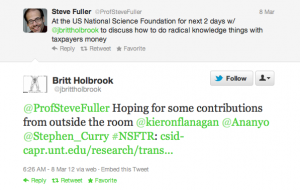 Looking at it now, I realize it was directed at very specific individuals; at the time, in conjunction with the email, I interpreted it as an open invitation and jumped into the conversation. My hope was twofold: to contribute directly and to showcase a Twitter tool which (in my active imagination) could be a “radical knowledge thing” that NSF could use in support of transformative research.
Looking at it now, I realize it was directed at very specific individuals; at the time, in conjunction with the email, I interpreted it as an open invitation and jumped into the conversation. My hope was twofold: to contribute directly and to showcase a Twitter tool which (in my active imagination) could be a “radical knowledge thing” that NSF could use in support of transformative research.
To announce my presence (@stephjoke), I tweeted “action today and tomorrow from a Transformative Research Workshop,” including the #NSFTR hashtag and website link. Periodically I tweeted, (in-between regularly scheduled events and other tasks of the day), waiting for my tech guy to get the visualizer (tentatively named Tidepool) up and running. (Last minute requests are always a challenge!) Don Blair came through, and I immediately shared the url and a series of screenshots.
Now, someone astute among readers will realize that a) Britt’s invitation may not have meant to include outsiders outside the room (since he clearly specified already-known insiders, and I do not know if I have previously met anyone who was ‘in the room’); and b) even if the invitation was meant to include strangers, I did not ask permission to run the visualizer, let alone analyzing the Tweet data. Which is why (during the conference), I Tweeted my affiliation with the proactionary principle, especially in terms of how it “encourages taking risks” - in contrast with the precautionary principle. My rationale was that Tweets are public data and more people than any of us can imagine are mining them for all kinds of things that we may or may not approve. At least I make what I do public!
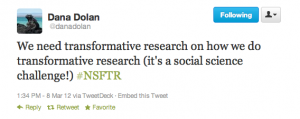 To be honest, I was not fully cognizant that I was actually already doing potentially transformative research (as described in @danadolan’s Tweet); only that I had an opportunity to demo Tidepool. The potential of analysis – of having enough data to justify engaging this as an actual case – came clearly into mind in the week afterwards, as I began prepping in earnest for an upcoming conference where Informed Consent is being negotiated in advance. Participants need an example in order to comprehend the implications of consent; what better way to provide them this information than to illustrate to what use I will put their Tweets?
To be honest, I was not fully cognizant that I was actually already doing potentially transformative research (as described in @danadolan’s Tweet); only that I had an opportunity to demo Tidepool. The potential of analysis – of having enough data to justify engaging this as an actual case – came clearly into mind in the week afterwards, as I began prepping in earnest for an upcoming conference where Informed Consent is being negotiated in advance. Participants need an example in order to comprehend the implications of consent; what better way to provide them this information than to illustrate to what use I will put their Tweets?
Data:
Here are some of the screen shots I shared with the #NSFTR (click to enlarge), and also posted back to the Science of Team Science listserv where Britt had made his original announcement. You can click through here to see and read Tweets from the #NSFTR workshop (and possibly on-going, as Tweeters continue to use the hashtag).
Analysis:
I am not going to get carried away because no one has given consent for me to venture even tentative interpretations! This entry is long-winded enough, and hopefully the inclusion of Tweet screenshots and commentary gives adequate flavor as to my style. It seems important, however, to be as explicit as I can with the methodology and ethics motivating this as action research. For instance, there are many disclaimers, such as that the majority of Tweets are from @jbrittholbrook and are thus unrepresentative of the whole group of participants (emphasizing why more participation is better), and that the Tweets are only a selection of everything that gets said, and that people outside the room can only make limited sense of the meaningfulness of Tweets read out of context.
Yes. These are some of the obvious conditions of communication involving a Twitter backchannel to a live, face-to-face event. If we are to be purposeful about engaging these conditions (i.e., if we are going to do social science), then we take them into due consideration as relevant factors and explore the dynamics that they bring into view. I am going to select one dynamical instance of data that I recognize as an instance of a transactional (communication) process which brings the social field of interaction into view such that we can assess whether identities or ideas are particularly relevant. The argument is that only by recognizing these interactional moments – specifically, our participation in the social norms and rituals of generating knowledge – can we come to identify the transformational. This identification is prerequisite for research that intends to be transformative.
Simultaneity is the Linchpin
 @JChrisPires’ Tweet came a few hours after the email I sent to the Science of Team Science listserv updating them on my activities with #NSFTR. In that email, I had also suggested a facilitative use of Twitter, such as asking everyone to Tweet the one word most characterizes transformative research. When I came upon@JChrisPires’ Tweet at the end of the workshop, I recognized it immediately. We were not asking exactly the same question, and we did not ask at exactly the same time, but the timing is close enough to suggest simultaneity. In physics, simultaneity requires a shared frame of reference, but in terms of social phenomena – such as the generation of new knowledge – simultaneity is a measure that incorporates both shared and different frames of reference simply on the basis of their co-appearance in the dimension of time.
@JChrisPires’ Tweet came a few hours after the email I sent to the Science of Team Science listserv updating them on my activities with #NSFTR. In that email, I had also suggested a facilitative use of Twitter, such as asking everyone to Tweet the one word most characterizes transformative research. When I came upon@JChrisPires’ Tweet at the end of the workshop, I recognized it immediately. We were not asking exactly the same question, and we did not ask at exactly the same time, but the timing is close enough to suggest simultaneity. In physics, simultaneity requires a shared frame of reference, but in terms of social phenomena – such as the generation of new knowledge – simultaneity is a measure that incorporates both shared and different frames of reference simply on the basis of their co-appearance in the dimension of time.
The association may seem far-fetched, however emerging social theories are considering simultaneity in some fascinating ways. For instance, Levitt and Schiller are conceptualizing simultaneity “to rethink the terrain in which social processes take place . . . [and] challenge our understanding of social reproduction” (2004: 1016). This is relevant because unless and until scientists are willing to investigate and interrogate their own social rituals of doing scientific research, little (if any) transformation is possible. Anna Madoeuf (2006) explains how to study mulids (festivals) only a few days long (as you read, please compare with the similarly temporary/transient nature of scientific meetings):
“Festivals only a few days in duration offer the researcher little real time to construct an analysis. The evanescent character of the festival drives a researcher’s quest for fragments. During a festival, everyone seems to live and act in an accelerated way and it is impossible to grasp the simultaneity of situations and scenes. Thus we have experimented with adapting sociogeographic methodologies to the roller-coaster landscape of the mulid, instantaneously capturing data created during aleatory, virtiginous peregrinations. We have chosen to accept the immediacy of the mulid and adapt research tactics — impressionistic, sampling — to its constraints. However, a broader field of more empirical analysis is also open to the researcher, because the festival is also a long-term product of less-ephemeral social, state, and urban organizing patterns, and cultural-political contestations: a mulid is debated, decided upon, struggled over, programmed, permitted, policed, and organized.” (in Cairo Cosmpolitan, p. 475).
Organizational consultant and identity theorist Evangelina Holvino has created a theory and skills of simultaneity necessary for countering what Amartya Sen calls miniaturization (2006). Miniaturization, I suspect (along with other dynamics), is part of what inspired #NSFTR Tweets about Thomas Kuhn (presumedly referring to the operations of normal science, which is what enables progress yet also stifles change). Talk about transformation (indicating a perceived need or desire for paradigm shift) probably offers evidence as to the crisis underlying modern scientific endeavors: crises that involve the social (whether we want it or not). This slideshow by Janet Sternwedel on Kuhn: Paradigms and Normal Science nicely illustrates the resistant problems (i.e. unexplainable) anomalies characterizing scientific crisis.
Proposal for Potentially Transformative Social Scientific Action Research
I would like to invite #NSFTR Tweeters (and anyone – everyone! – else who is interested) to follow the next Tidepool experiment (idiographic case #2). You can read the original proposal that was accepted by the conference organizers of a mini-conference on The Promises and Challenges of Dialogic Pedagogy at Reflexivity – upcoming. The conference features experts on language and education. While, at first glance, there may not appear to be any relationship between the #Bakhtin and #NSFTR events, my colleague James Cumming and I have offered a potential frame in which to make sense of “ notable incidents of language use … [further defined as] challenging moments where identities surface as relevant in particular interactions.”
The catch is that “identities” are not usually ends-in-themselves, rather they surface in service of a task or function within a group that is working (more-or-less) “together” on a matter of common (or at least overlapping) interest. In the manner of most academic conferences, however, this group of Bakhtinian practitioners has not defined a collective goal or aim for a definitive conference outcome. (From the #NSFTR workshop Tweets, I gather that there was – likewise – no intentional deliverable. Is this a polarity to be managed or a problem to be solved for the conduct of potentially transformative research?)
We are currently in the process of extending the negotiation of Informed Consent with the conference organizers to include #Bakhtin conference participants. The global task we are proposing for the purpose of the action research project is to explore whether participants can collaborate on the scale of collectively co-constructing an outcome for the group-as-a-whole: i.e., a message of some kind that represents a voice of/from the conference, something considered meaningful enough by all (or at least most participants) to share with others. An example could be coming up with a definition of “transformative,” or perhaps a list of emergent interpersonal/interactional factors that indicate the presence of potentially transformative dynamics, or even a White Paper on communication skills for transformation. These examples are suggested with the hope that they might be taken up as actual proposals! Thus defining parameters for assessing stages of group development and creating a social container within which identities can be foregrounded if/when/as they become relevant. Whether conference participants agree to engage “dialogically” with such an “Other” as #NSFTR scientists is, of course, one of the crucial questions upon which the stakes turn.
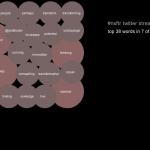
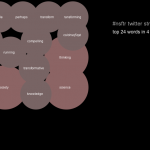
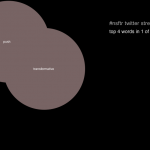
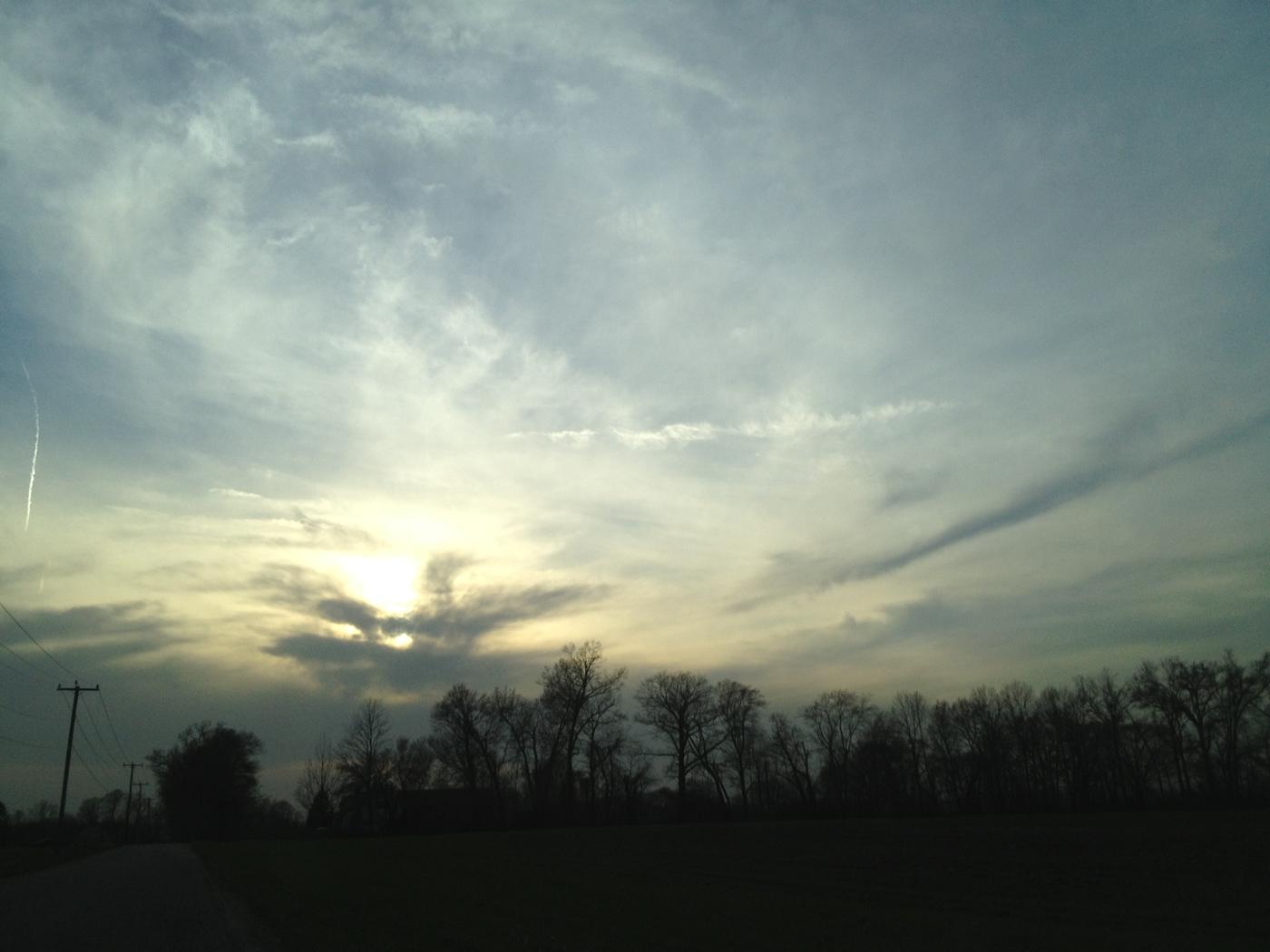







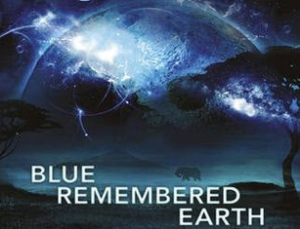
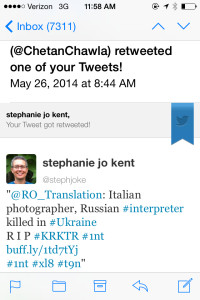



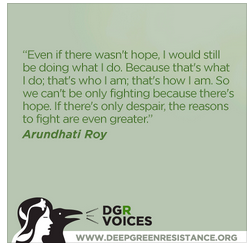



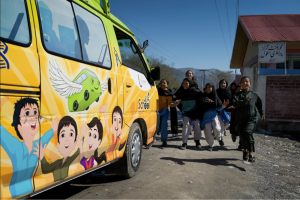
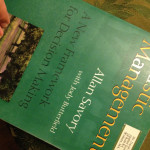

Hi, Steph:
By “outside the room” I meant, quite literally, outside the room. There seems to me no reason to go on Twitter if one is not inviting public comment. Unless they are private messages or one’s account is somehow restricted, I take Twitter to be public speech.
So, both your comments and your clouds were quite welcome!
As for simultaneity, I wonder whether you’ve considered Lyotard’s account of the phrase in The Differend. For Lyotard, the time of every phrase is now, and so linking onto one phrase with another brings them into a sort of simultaneity. Might be really interesting to think of your word clouds in terms of linking phrases, as well as in terms of quantity of words.
Britt
[...] Doing Transformative Research | Reflexivity. Tweet This entry was posted in Transformative Research. Bookmark the permalink. ← Amazon vs. Apple: Competing Ecosystem Strategies [...]
We are developing the Tidepool “clouds” in that direction, Britt – perfect forecasting!
A couple of engineering students from the National institute of Engineering in Mysore (Karnataka, India), under the direction of Assistant Professor M. J. Yogesh, are working on developing the open source code.
All ideas for how we can make the tool usable and user-friendly are welcome!
Hi Steph,
I’ve been trying to respond to Britt’s intriguing suggestion of thinking of word clouds in terms of linking phrases, as well as in terms of quantity of words. This is as far as I got.
A differend occurs when a discourse does not allow the linkages which would enable the presentation of a wrong, e.g. a case of conflict between parties that cannot be equitably resolved for lack of a rule of judgment applicable to both. In this case, the ability to access particular identities and their resources which would enable the parties to communicate with each other is impeded by the lack of a shared discourse of justice. In other cases, it may be that discourses that denigrate certain identities do not allow the linkages which would enable their enactment in a particular time/space. The word clouds may be an indication of a simultaneity of uniqueness of who and who is not making meaning.
Best,
James
Lyotard’s idea of a phrase is simple — and not all linkages give rise to differends. A phrase contains 4 instances: the addressor, the addressee, the referent, and the meaning. One phrase links onto another by means of these instances. For instance, this phrase links onto the former by referring to it.
It occurs to me that hashtags in twitter link different tweets insofar as those that share a single hashtag in common all have a common referent.
According to Lyotard, linkages happen according to rules established by certain “phrase regimens” — for instance, logic, or legal language, or mathematics, all of which can be used in differnt “genres of discourse.” Genres determine stakes (the finality, telos, or goal toward which phrases are aimed). Genres are like the game, stakes are like the object of the game, and regimens are like rules. So, if chess is the genre, checkmate is what is at stake, and different pieces are like regimens. Sort of.
Now when one genre and another get into a conflict over a particular phrase (let’s pick something obviously controversial, like the claim “marriage only happens between a man and a woman”), a differend can but need not occur. Let’s say that gay couples want to get married, but cannot legally do so. It would be possible to change the law, and then they could get married legally. Indeed, the genre of the law and the genre of love are then in agreement. There’s no differend there. But let’s say that gay marriage is illegal, and a couple wants to get married. They talk about how they are in love, life partners, live together, til death do them part, and so on — but they are not legally married. Then, one gets incapacitated and the other cannot make any decisions, since she lacks all legal standing. If she is able to come to some resolution, there is still no differend. If, however, the law bars her from making any decisions about her wife (who legally would not be her wife), then we have a differend. The wife who is still with it has no way to make her case that she should be able to make decisions for her loved one who is incapacitated.
I was really only referring to the idea of linking one phrase to another that Lyotard presents in The Differend, rather than to the idea of a differend. I suspect even displaying linkages that don’t lead to differends would be difficult enough. But I know nothing about writing computer programs.
Sorry if this is TMI.
Hiya James and Britt – look at you two go!
Definitely not Too Much Information – but let’s figure out how this all can inform practical problem-solving, can we?
What I understood from my distant vantage point on the National Science Foundation’s Workshop on Transformative Research (TR) is that it would be useful to generate a definition for “transformative research.”
Tidepool might help us get there, because it will collect uses of the terms, “transformation,” “transformative,” “transformatory,” etc and also uses of “research” (and possible synonyms – which do not leap to mind, interesting!).
Additionally (soon I hope), Tidepool will show the word cloud terms in context, so if (for instance) #NSFTR tweeters start offering their own definitions, we could begin to parse the associations and relationships in the specific and particular language use. Perhaps we can cull a commonsense definition that makes sense across disciplines and even to lay people, too.
The simultaneity theory comes in by keeping our eyes/minds/ears wide open to inspirations from other spheres, noticing connections and divergences, perhaps identifying which metaphors are useful or tangential, and who knows what else. If we’re going to create a definition with power (meaning, with discursive force that indexes a possible future), the simultaneity theory suggests that we need to remain aware of our “nestedness” in layers of communication processes that are all interacting with each other (and us).
Specifically, identity issues (interpersonal, intercultural) that emerge during the effort of generating a definition together may be a clue to the potential of a transformatory possibility – if we can figure out how to recognize and engage it!
The point is (from my perspective), identity issues (at the level of a differend and also less extreme) offer evidence that something is effecting the task the group is collectively engaged in achieving. There may also be other kinds of communication dynamics that provide these clues. We will only discover this if we’re willing to allow ourselves to be examined as we interact with each other as we perform (and talk about doing) the work.
Hi Britt, Steph, and James,
This is a fascinating conversation.
Without going into my whole diatribe on “postmodern biology”, I will just point out that Twitter hashtags are phenomenally useful way to “attend” multiple meetings in real time.
My graduate students would love to have their lab notebooks and thoughts all “online” also, and our conversation about this “transformative” aspect of science culture and practice is almost (but not quite) as fun as the “doing” of science itself.
Cheers, Chris
@stephjoke — I can see how that might work, though we were not trying to come up with a definition of TR. In fact, we were attempting to remain open to the fact that any definition might quash the sort of ‘remaining open’ that your simultaneity theory wants to maintain.
@Chris — if you want to experiment with a platform for allowing your students to publish stuff online that they can all see and respond to, you might take a look at peerevaluation.org. I like the site, and it may suit your purposes.
Britt
Steph,
Thanks for provoking this intriguing conversation. As an “outsider” that went “inside” the room yet remained an outsider with respect to the workshop conversation, what’s most fascinating about both conversations to me is what isn’t going on.
The workshop’s objective (source: https://csid-capr.unt.edu/research/transformative-research-workshop ) was to “(1) Identify gaps in our current thinking about PTR, (2) Provide greater conceptual clarity to the complex of issues surrounding calls for NSF to better promote ‘potentially transformative’ research, and (3) Develop a research agenda that goes beyond the typical intradisciplinary engagement of scholars with scholars on areas of interest only to those scholars.” These are laudatory goals, and I look forward to the workshop report. As one “insider” workshop participant suggested, this has been an ongoing or at least recurring quest, and perhaps would never be fulfilled.
What comes to mind from my inside-outsider experience at the workshop, and from the conversation you’ve prompted here, is Einstein’s familiar quote, “We can’t solve problems by using the same kind of thinking we used when we created them.” It’s a “wicked problem” (Rittel and Weber 1973): one characterized by incomplete, contradictory, and changing requirements. Funtowicz and Ravetz (1993) suggest that approaches such as peer reviews are insufficient to ensure that quality decisions are made when issues involve high uncertainty and have potentially large repercussions. They suggest using extended peer reviews that incorporate knowledge from multiple perspectives from different scientific disciplines and from the public as a way of breaking free of traditional thinking patterns. I hope the #NSFTR team will consider ways to broaden the conversation beyond scientific experts, no matter how brilliant the workshop experts are (and I was deeply impressed!).
I am grateful to have had the opportunity to observe the workshop conversation first hand. Many thanks to Britt for alerting us “outsiders” to the workshop, and for his valiant efforts to tweet and run the workshop at the same time (a tall task for anyone!). Best wishes to the entire workshop team.
Dana Dolan
School of Public Policy
George Mason University
The Interdisciplinary Blues
Woke up this morning
Had a thought in my head.
How do we do that inter-disciplinary shit?
Can I do it in bed?
Those internal conversations
Man they can be mean
Got to have me some simultaneity
Then I can join that team.
I am very grateful to Britt for the clarification on the idea of a differend and the example. In the scenario of an illegal gay marriage where one partner lacks the legal standing to make decisions for the other, I can imagine a conversation taking place where there is a moment when the couple realize they have no voice. I am wondering then if it is possible to experience a differend? Is that valid question?
@jchrispires and @danadolan – I’m thrilled to have you both join the conversation – not to mention how you’re inspiring James! (Although I think he’s written a rap verse, not a soulful blues tune…)
Dana, can you say more about “what isn’t going on”? I want to be sure that I understand . . . are you saying that the TR workshop did not accomplish its predetermined tasks? Thanks for listing the three objectives, btw – they provide context for Britt’s comment that workshop participants were not trying to come up with a definition.
Britt, I know what you mean about definitions having the potential of quashing creativity, that’s the downside of normal science, everyone gets comfortable inside the box. I am more interested in the process of trying to generate a definition than I am the final product itself – although I hypothesize that language is flexible enough to come up with a phrase that indexes transformation, which seems to me to be the crux of the “wicked problem” challenge. Do you know this concept of indexicality?
The metaphor of an index comes from sociolinguistics (Charles Pearce, Michael Silverstein); but I tend to think of it in terms of math. Every use of language has a vector – words, phrases, utterances, written statements always ‘point’ somewhere and instill (at least the intention of) motion in that direction. I think what happens at most academic gatherings is that we “talk about” rather than “talk toward” (that’s why they’re called conferences, right – assemblies organized to confer with each other).
Dana, I’m wondering if it is these deep norms of “talking about” that you sensed? I’m also curious about how you are configuring yourself as an outsider/insider. You were invited – to me that indicates you’re in! Yet, simultaneity theory reminds me there are always multiple identities at play, so I don’t want to miniaturize you or dichotomize our interacting on the basis of a polarization. How do you experience/understand yourself as being an outsider? And, I’m wondering if it is this dual positioning that allowed you the critical perspective to be aware of both what was and was not getting done.
If we were going to try to come up with a definition for transformative research, it needs to characterize, indexically, the wicked problems it intends to solve. For instance, the language of transformative research probably has to also be incomplete, contradictory, and adaptable to changing requirements. The mixed-discipline and non-scientist/public input that you’re suggesting (citing Funtowicz and Ravetz) for peer review of proposals for potentially transformative research is a prescription for a method that might generate this new, transformative way of talking. By doing it, we would not only talk the language of transformative research into being, but we could begin to live the realities of transforming – ourselves and society.
@James — really a very good question. Lyotard resorts to the idea of an ‘event’ to which we link with the phrase ‘Is it happening?’
This takes us beyond the Kant of the First Critique, according to whom we can know only objects of possible experience (that is, what can be subsumed under the categories of the understanding). This is why Lyotard pays a lot of attention to the Third Critique (though I personally think there’s a lot in the Second Critique that’s relevant to this issue of what can and can’t be known). Suffice it to say that it is an open question whether one can experience something one knows not what. I certainly believe this is possible.
@Dana — thanks for coming! The interesting thing when engaging public funding agencies is to find a way to do so critically without alienating them. I myself am in favor of getting beyond the dichotomy where we either ‘speak truth to power’ (as if we knew what ‘truth’ and ‘poer’ were) or are totally co-opted by the powers that be.
@stephjoke — the vectors are very close to what Lyotard has in mind with the stakes of a genre. Genres use different phrase regimens to incline phrases toward a specific goal (the stakes of the genre).
[...] upcoming Previous Post:Doing Transformative Research [...]
Steph, thank you for the warm welcome and interesting questions. Time pressures are upon me, but in response to one of your questions, my hunch is that it’s premature to say whether the workshop did or did not accomplish its assigned tasks, however that’s a question for others than me to answer. My point was that the larger goal that the workshop is meant to support is unlikely to be reached due to the wicked nature of the challenge. Any formulation of the problem is contextual and dynamic, and any approach taken (I’ll avoid calling it a “solution”) also serves to change the problem, thus requiring new formulations and approaches. So yesterday’s transformative research is today’s standard process; today’s cutting edge work will be passé tomorrow, the cycle will continue indefinitely since the objective is to continually raise the bar. Under these conditions, it may be more productive to shift the focus from *rethinking the process* of doing peer review of proposals for potentially transformative research, but on *rethinking the process of thinking about the process* of doing peer reviews of proposals.
Britt, thanks so much for your warm welcome as well. I can only begin to appreciate the challenge in getting beyond the dichotomy you described so beautifully: “we either ‘speak truth to power’ (as if we knew what ‘truth’ and ‘power’ were) or are totally co-opted by the powers that be.” Much of this dynamic is obscure to me from my outsider vantage point. Yet perhaps by reflecting on who is included in your reference to “we,” and by thoughtfully expanding this membership (carefully taking into account the challenge just referenced), one might shift the existing power relationship, suggest new approaches, and open up new possibilities for getting beyond the dichotomy. Drawing from Meadows’ (1999) list of leverage points (ref: http://www.sustainabilityinstitute.org/pubs/Leverage_Points.pdf ), the emphasis would move to levels 4 through 1… “in increasing order of effectiveness,” Meadows claims. What “outsiders” offer is the ability to ask different questions, some of which simply add noise to the signal, while others –often experienced as uncomfortable questions by those embedded in the status quo– may challenge assumptions, shift thinking in a new direction, and open new possibilities.
Dana, I am grateful and amazed at the time contributed to this conversation by you, Britt, Chris and James.
Each of you has demonstrated a communication skill known as “nexting” – you have provided a step or hook that, if taken up, has a vector. Britt, would you say the apparent commonality of this direction is an example of Lyotard’s stakes of a genre? I find the mathematical concept of a vector a useful metaphor because it explicitly involves both time and space. In our efforts to discover leverage points for systems change, James and I keep returning to time and timing (specifically, simultaneity) as a clue to the presence of conditions inclined toward change.
I am fascinated by the emphasis on leverage points in systems change (Meadows 1999) because the notion of a “point” situates a place but not a time. Points are “whats” not “whens.” The implication of this lopsided attention to spatiality is that we disregard our own rituals of interacting with each other in time. Mikhail Bakhtin demonstrated that the way we use language not only displays our orientation to time, it molds timespace into chronotopes. In other words, Bakhtin teaches how language use constitutes the human experience of temporality. Michael Holquist uses the term calibration for this process.
Dana, I completely agree that the challenge is less rethinking the ‘what’ of peer reviews, and instead rethinking the ‘how’ of evaluating potentially transformative research proposals. Streek and Jordan (2009) describe Communication as a Dynamical Self-Sustaining System: The Importance of Time-Scales and Nested Context in interpersonal communication. The notion of nested time-scales seems crucial for the purposes of comprehending what might be potentially transformative research: does the proposal itself begin to generate new rituals whose benefits accrue to the long-term? It seems to me that transformation depends upon motion, not position – it is a question of calibrating rates and paces rather than pinpointing location, of comprehending the nested context of our communication within several time scales, simultaneously, and articulating ourselves with as much cognizance as possible of the implications at all timescales.
Also, I want to alert you all to the brief analysis I wrote up of this blog comment exchange: Potentially Transformative Research.
and if you haven’t seen my Twitter invitation, please check out my current action research project and share the invitation widely!
Proposal for Potentially Transformative Social Scientific Action Research: Simultaneity is the Linchpin
[...] frequency with the topics of each workshop. As with the National Science Foundation tweet data (Idiographic Case #1) from their Workshop on Transformative Research, the tweets that Tidepool captures represent only a [...]
Hey! Something’s wrong here! J. Chris Pires posted a comment asking where this is going. It is an excellent question, and I had begun an answer but lost the link that I wanted to show and have not gotten back to recreating it yet. Maybe I better get busy!
Meanwhile, Britt posted the link to the official report on “The Promise and Perils of Transformative Research” – it’s a downloadable pdf: http://csid.unt.edu/files/TRW_FinalReport.pdf
(I am pretty sure the report is awesome.)
Thanks, Steph — though you might want to read the report first!
Will we see any clouds depicting it?
Britt
Hi Britt
I was right – the report on “the Promise and Perils of Transformative Research” is excellent. I especially appreciate that you included all of the pre-conference submission documents. They illustrate the depth and give context the themes summarized in the report.
What is not clear to me is an articulation of the path forward.
I suppose I’m tossing Chris Pires’ question back – “where is this going?”
There are a few points which I am considering for elaboration, but first I wanted to share this word tree with you.
[caption id="attachment_17250" align="alignright" width="1009"] Word Tree of the blog entry, Doing Transformative Research” and comments (through March 2012).[/caption]
Word Tree of the blog entry, Doing Transformative Research” and comments (through March 2012).[/caption]
I created it in the tool, Many Eyes. I intended to share it with you for the report, but somehow the data didn’t get saved/stored so no one else could go in and verify it. Anyhow, I think the word tree illustrates something quite interesting, maybe even important (?), about how to move ahead with establishing criteria for assessing potentially transformative research in the review process.
Okay Britt, I suppose some explanation as to *what* the word tree illustrates is in order, eh? And perhaps a thought or two on how it differs from, and complements, the formal report. I’m hopeful Dana and Chris might rejoin the conversation too, as well as others.
What is raised about transformative research in both formats (the formal report and the blog commentary) are that no one knows how to predict whether this or that research proposal will turn into something transformatory. There is also a deeper debate about the desirability of intentionally transformational scientific investigation. Both questions involve control, which may be the beating heart of normal science: knowledge is established on the basis of what can be experimentally controlled.
The contrast between the two formats is that in the report (and presumably during the workshop itself), the focus is one-sided and exclusively on evaluating the content of a proposal for scientific research. The implication is that the information represented by the language of the proposal is sufficient, in and of itself, for indicating the presence or potential of something possibly transformative. The blog comments, however, stemming as they do from a random Twitter encounter, explicitly engage the other dimension of all communication processes – the rituals and dynamics of social interaction. This is captured in the word tree diagram posted in the previous comment.
I gather that the desired outcome of the NSF Workshop on Transformative Research was to generate some principles or guidelines for innovation in the review process itself. Is that correct? I may have interpreted it that way in accordance with my bias toward action and movement, because I see that there are no such recommendations presented in the report. I can elaborate, if anyone is interested, on how a social scientific theory of simultaneity could inform decision-making in the scientific review process by taking into account both ritual and informational dimensions, and using the dynamical interaction between these as an indicator of the presence of PTR.